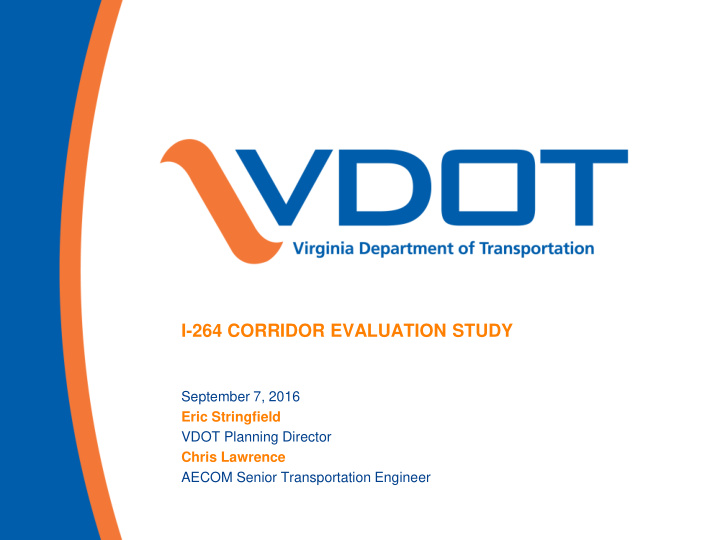



I-264 CORRIDOR EVALUATION STUDY September 7, 2016 Eric Stringfield VDOT Planning Director Chris Lawrence AECOM Senior Transportation Engineer
Study Overview Interchange Locations
Study Context Follow-up to I-264 Corridor Study (2006) Planning Level Study • Not based on survey data • Preliminary cost estimates in 2015 dollars Study Purpose …to identify appropriate improvements to the facility to adequately accommodate forecasted mainline freeway traffic volumes. Once adopted, the plan for improvements to the I-264 freeway lanes will serve as a guide in the design of improvements to the interstate.
Improvements Context FHWA Conditions on Acceptance of Expressway into Federal Interstate System as I-264 • Improvements will bring existing roadway into compliance with current standards • Mainline lanes are 11.5’ in width vs. 12.0’ in width • Narrow shoulders • Bridge clearance • Ramp design speeds • I-64 Capacity Widening • Add lane or temporary shoulder lane use in each direction on I-264 from Northampton Boulevard to Indian River Road
Network Context For analysis, the network has been modified to add: • Improvement associated with I-64/I-264 widening WB I-64 to EB I-264 • Construction starting FY 2017 • HRTAC Funded • Extends to Witchduck Road • Relocation of Greenwich Road over I-264 • Virginia Beach SGA Recommendations • Extension from Bonney Rd to Virginia Beach Blvd over I-264 (CBD/Pembroke SGA) • Extension of Sentara Way to Bonney Rd (Rosemont SGA)
Main Lane Line Improvement Configuration
Main Line Lane Configuration
Military Highway • Preferred alternative considered future potential LRT access • Weave segments are removed • Principal deficiencies involve roadway geometry • Cost $ 152.6M
I-64 • Accommodates HOV lane extensions on I-264 • Addresses EB and WB congestion coming from Virginia Beach • Can be implemented in stand-alone phases • Will require added lanes on I-64 during peak periods • Cost $ 466.9M
Newtown Road • I-264 widening included • I-64/I-264 (HRTAC) associated improvements address deficiencies related to eastbound traffic flow • Westbound improvement routes all traffic from Newtown to loop ramp, removing weave with I-64 on-ramp • Cost $229.1M
Witchduck Road • I-264 widening included • I-64/I-264 (HRTAC) associated improvements address deficiencies related to eastbound traffic flow • Westbound on and off ramps will function adequately with Witchduck Road widened to 6 lanes. • Improvements will not impact LRT extension • Cost $361.4M
Independence Boulevard • NB Independence to EB & WB I-264 free-flow movement • WB Slip ramp access to EB Bonney Road • Removes weave movements • Does not address congestion at EB off-ramp merge with SB Independence • Cost: $465.6M
Freeway Widening Independence-Rosemont Widen to 6 lanes (HOV+5) Cost $ 276.8M
Rosemont Road • Tight Diverging Diamond • Add Sentara Way connection over I-264 per SGA Plan • Close Bonney Road intersection • Rosemont widened to 6 lanes in CLRP • Cost $459.1M
Laskin Road & Lynnhaven Parkway • Lynnhaven Parkway not included in study • Prior planning produced preferred improvement alternative • Ramps to and from South Great Neck Road were considered Phase 1 of plan implementation
First Colonial Road • SPUI (Single Point Urban Interchange) • First Colonial Widened to 6 Lanes • Combines 2 traffic signals to 1 • Removes substandard ramp configuration in SE quadrant • Cost: $75.2M
Parks Avenue & Birdneck Road • Parks Avenue no improvements needed • Birdneck Road minor modification by City in association with Arena
Summary of Alternatives
Summary of Study Key Findings • No freeway widening needed east of Rosemont Road • No interchange improvements needed at: • Parks Avenue • Birdneck Road • Laskin Road • Improvements only to Westbound movements at: • Witchduck Road • Newtown Road • Improvements at Rosemont and at First Colonial predicated on widening of arterial to 6 lanes, and Rosemont includes Sentara Way extension. • Independence Boulevard improvements remove weaves and provide for direct movement from northbound Independence to westbound I-264. • I-64 interchange addresses most severe deficiencies and can be implemented in stand-alone phases.
Next Steps Individual improvement projects would need to be in CLRP, with identified funding sources and will require approval from FHWA. A typical outline of tasks: o Interchange Modification Report (Required by FHWA & VDOT) Analysis of alternatives Impact assessment Cost Estimates o Environmental Document Public involvement opportunity Preliminary Engineering Public Hearing HRTAC funds scheduled for Agenda discussion in September 2016 PE I-64 / I-264 Interchange ($10 Million)
I-264 CORRIDOR EVALUATION STUDY September 7, 2016 Eric Stringfield Planning Director Chris Lawrence AECOM Senior Transportation Engineer
Recommend
More recommend